This article may contain affiliate links, and I will be compensated if you make a purchase after clicking on my links (at no additional cost to you)
American bullies make some of the most loyal, loving pets, and there are tons of benefits to this breed. However, they don’t have the best skin, and to keep your bully healthy, you’ll have to look out for some common skin conditions that could cause discomfort and itching.
Here are 6 of the most common American bully skin problems:
- Canine Atopic Dermatitis (Allergies)
- Ichthyosis
- Pyoderma and Intertrigo (Skin Fold Dermatitis)
- Yeast Infections and other Fungal Infections
- Skin Mites such as Demodicosis Mites
- Eczema
Let’s discuss these common skin issues and how to diagnose and treat each one. Then, I’ll tell you about what causes these conditions and guide you on how to provide your pup with the care they need so that your bully can stay healthy, itch-free, and happy for the rest of their days.
1. Canine Atopic Dermatitis (Allergies)
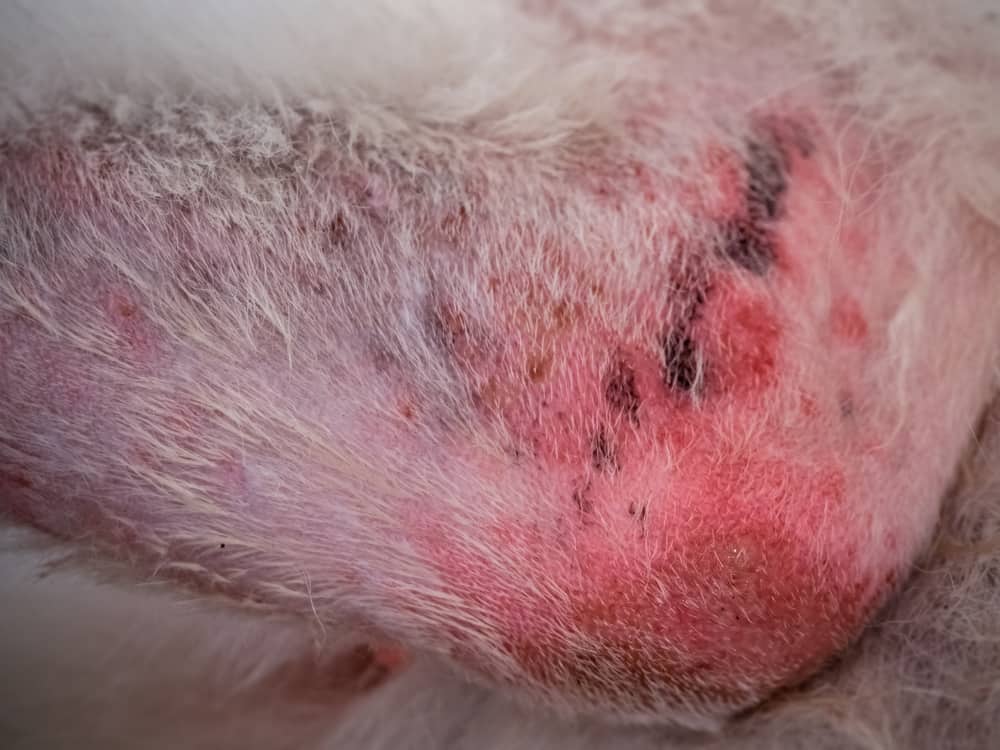
Canine atopic dermatitis (CAD), to put it simply, is an allergic reaction. CAD is one of the most common skin problems in American bullies since they often have allergies passed down from generation to generation.
CAD usually presents itself when a dog is between six months and three years old, although it may occur later in a dog’s life if they develop an allergy later from overexposure.
Certain breeds of dogs, such as American bullies, are more prone to developing CAD. My dog has it from allergies, getting bumps on the head, rashed in the armpits when exposed to an allergen.
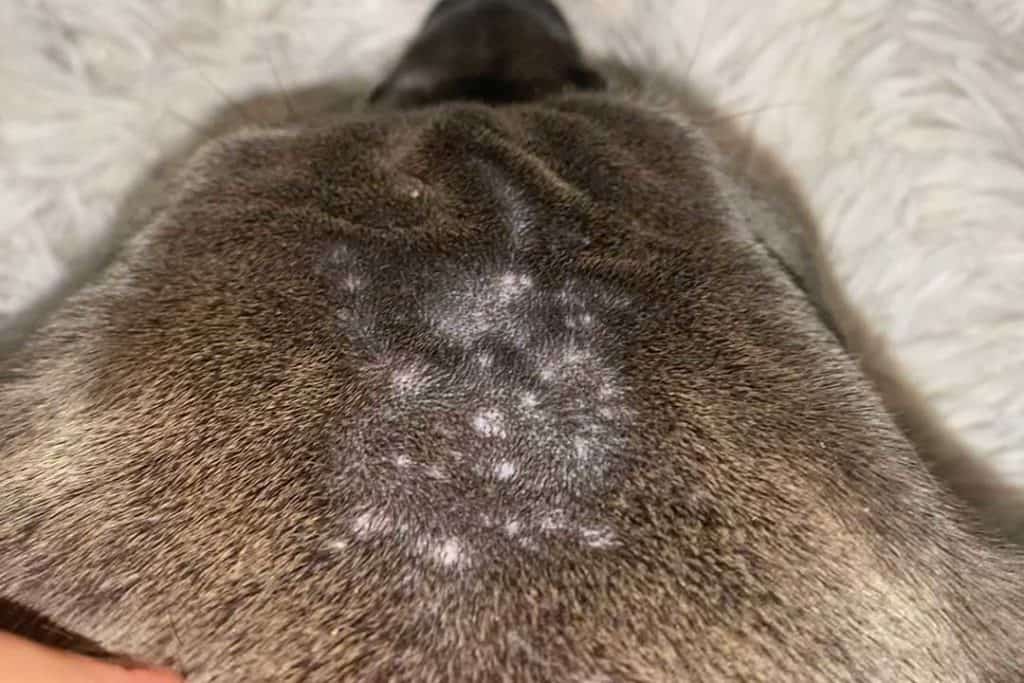
However, this hereditary condition can also affect many other dog breeds and mixed breed bullies of any variety, so even if your American bully is a mutt, they might develop canine atopic dermatitis.
How To Diagnose CAD
CAD may be challenging to diagnose, especially since it causes symptoms that look just like those of other skin conditions.
The symptoms of atopic dermatitis are:
- Pruritus (a fancy name for constant and uncomfortable itching)
- Redness and lesions around the face, ears, belly, and butt, and inside the arm, paw, and leg joints
- Bacterial or yeast infections inside the ears as a result of constant itching
- Eczema
These itchy, red patches and lesions, characteristic of CAD, are like allergic skin reactions in humans.
The most common allergens that trigger CAD for bullies are:
- Fleas
- Pollen
- Grass
- Mold and mildew
- Certain foods, including yeast
- Bacteria that naturally colonize on a dog’s skin
Diagnosing CAD requires you to make some deductions. You may need to ask yourself:
- Does my dog have fleas? If so, the skin condition could be treated by flea remedy and pest eradication in your home.
- Did my dog develop this condition due to environmental allergens such as pollen or grass? For example, if it’s springtime or your dog seems to be itchier every time you mow your lawn or go for a walk in thick grass, your dog might have an allergy to pollen or grass. In this case, treatment with vet-prescribed medicated baths and a daily dose of oral antihistamines is usually your best bet.
- Could my dog have a food allergy? Dogs can be born with food allergies, but they can also develop them over time. Generally, to eliminate the possibility of a food allergy, feeding your dog a wheat-free, beef-free, and dairy-free diet is the best treatment. You may also choose to have your dog tested for allergies at your veterinarian to be sure.
- Is there mold or other fungi in my home? If there could be fungal growth in your home, or if you just moved to a new residence, your dog might be reacting to the new allergens in your environment. Usually, keeping your home clean and taking your dog to the vet to get medicated shampoo, antihistamines, steroids, or allergy shots is the best treatment.
- How clean is my bully? Yeast and bacterial buildup in your bully’s skin may be the cause of the allergic reaction. Keeping your bully clean and wiping off the creases in their skin is often the best way to avoid these infections, but once they set in and cause CAD, you will need to seek an antibiotic or antifungal treatment from your vet.
How to Treat CAD
CAD can be very uncomfortable for any dog, so you should take them to the vet if you suspect they have any allergies.
Vets are best equipped to determine the cause of CAD, and will tailor treatments to the underlying issue. To test for CAD, your vet will run an allergen panel on your pup, which will ensure that you know everything your bully is allergic to.
If your bully does have allergies, your vet will likely prescribe one or more of these medications and treatments:
- Medicated baths
- Antihistamines
- An allergen-free diet rich in omega-3 fatty acids
- Immunotherapy shots
- Steroids
- Antibiotics
2. Ichthyosis
Ichthyosis comes from a Greek word that means “fish” since this condition causes dry, flaky skin patches that look like fish scales. American bullies are prone to developing this condition in particular, and there is even a specific category of this disease that only presents in American bullies.
Ichthyosis is a hereditary disease, and it is incurable. Most bullies with ichthyosis show signs of it when they are young puppies.
How To Diagnose Ichthyosis
Diagnosing ichthyosis in American bullies is more straightforward than other skin conditions because of its unique symptoms and early presentation.
Dogs with ichthyosis present the following symptoms:
- Affected puppies have wiry hair and a thin, ragged coat
- Thick, calloused patches of dry skin with minimal hair growth
- Thickened paw pads
- Dandruff
- Greasy flaking skin that is difficult to remove or clean
- Possible cracks in the dry skin, which may cause bleeding and discharge
For a positive diagnosis, vets can take a biopsy of the affected tissue and test it. However, most of the time, ichthyosis is easy to identify with a simple physical examination.
How To Treat Ichthyosis
Although you cannot ever cure this condition, there are many ways to soothe the dry, flaky, irritated skin of bullies afflicted with ichthyosis.
Generally, topical skin treatments are the best way to soften and restore skin. Vets will usually prescribe a medicated shampoo and an oil-based moisturizer to keep the patchy skin from cracking or getting too irritated.
Regularly brushing your dog can help distribute oils throughout their coat at home, preventing breakouts and dry patches.
There are also a couple of medications, such as isotretinoin, that vets can prescribe to help with the symptoms. Still, these prescriptions usually have so many adverse side effects that they are only used as a last-ditch effort for severe cases.
3. Pyoderma and Intertrigo (Skin Fold Dermatitis)
Intertrigo is a type of pyoderma. These conditions describe severe skin irritation between a dog’s skin folds from chafing, excessive moisture and heat, and bacterial infections that root in warm, humid areas.
Generally, in medical classification, intertrigo is a less severe case of skin fold pyoderma. Still, both can be called pyoderma, so if your vet diagnoses your dog’s skin condition as either one, the treatment will likely still be the same.
How To Diagnose Pyoderma and Intertrigo
Pyoderma and intertrigo only affect skin folds, where your dog’s skin is warmest and the most humid. This skin often rubs against itself, causing inflammation, and when the area becomes irritated, it is more susceptible to infection.
In addition, skin folds are the most common places where bacteria like to colonize, which can, in turn, irritate your bully’s skin.
So, in the case of pyoderma and intertrigo, bacteria and irritation usually go hand in hand, and it can be challenging to tell which one came first.
In American bullies, you may notice this condition in the face, nose, tail, toes, armpits, ear folds, vaginal folds, or anywhere your dog has creasing, looser skin.
The most common symptoms of pyoderma and intertrigo are:
- A foul odor coming from the dog’s skin folds
- Oozing or excessive heat and moisture in the skin folds
- Hair loss
- Redness and irritation in skin folds
How To Treat Pyoderma and Intertrigo
Usually, pyoderma and intertrigo are simple to treat.
If the irritation is minor, wiping the area with a benzoyl peroxide wipe and applying a steroid cream prescribed by your vet is the best treatment. This process will eliminate infections and keep the site clean and dry.
If the infection is more severe or if there are any open lesions between your bully’s skin folds, your vet may prescribe an antibiotic, antihistamine, or steroid.
Dogs who get chronic pyoderma and intertrigo may benefit from a “facelift,” in which your vet surgically removes some of the excess skin and tissues from the affected area.
4. Yeast Infections and Other Fungal Infections
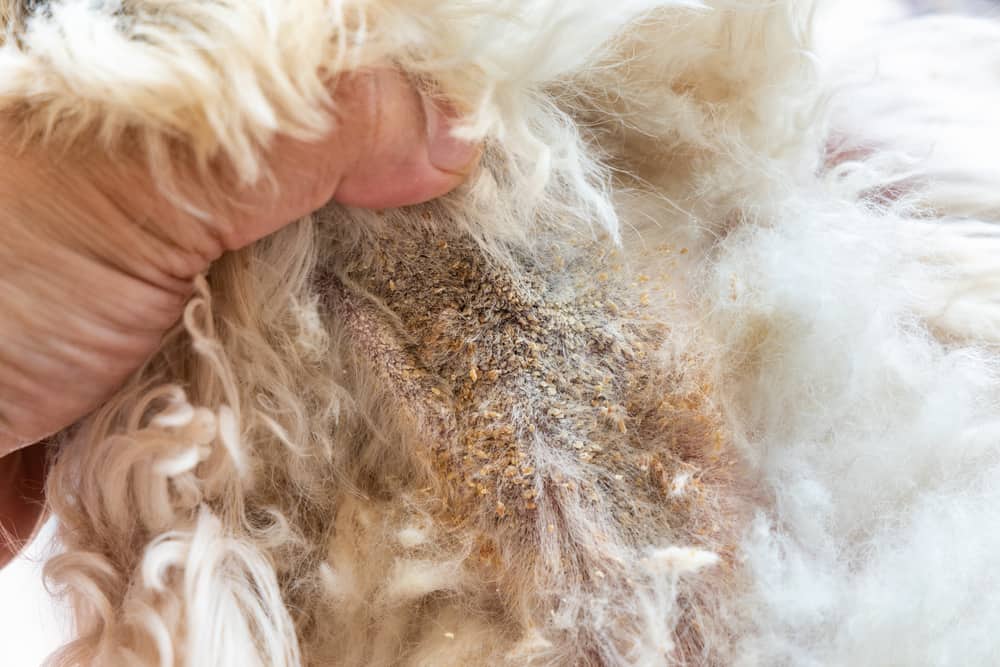
Yeast infections are by far the most common type of infection that American bullies suffer from, but several other types of fungus can also colonize on your dog’s skin.
Skin-growing fungi like yeast prefer to live in warm, dark, moist environments, making your bully’s joints and skin folds prime real estate for these microscopic organisms. Add extra environmental humidity or a nearby body of water to the mix, and you have a perfect recipe for infection.
How To Diagnose Yeast Infections and Other Fungal Infections
Fungal infections usually look similar to bacterial infections and pyoderma, and all of these conditions are generally present in a dog’s skin folds, joints, paws, and ears.
However, there are a few ways to differentiate the two infections.
So, let’s look at the symptoms of fungal infections:
- A sour, yeasty smell
- Reddened ears and/or skin folds
- Waxy, dark discharge covering the affected area
- Constant itching, chewing or rubbing
- Potential hair loss or skin flaking
How To Treat Yeast Infections and Other Fungal Infections
Usually, you will need to get antifungal cream, drops, shampoo, wipes, or spray from your veterinarian if you suspect that your dog has a fungal infection.
Generally, these products include an antifungal ingredient such as miconazole, which can kill the fungi and keep the area clean and dry for quick recovery.
However, if the fungal infection is severe, your vet may prescribe an oral antifungal to ensure that condition goes away completely.
To prevent infections in the future, keeping your dog’s skin dry and clean is the best practice. If they have any skin folds, be sure to wipe them regularly to keep fungi from building up and taking over.
One more thing to note– if you do any research on fungal infections in dogs, you may notice that there are tons of home remedies out there, such as tea tree oil, peroxide, and vinegar washes. However, these ingredients may cause more harm to your dog’s skin than good, and none of them are tested and approved as of yet.
So, when you’re dealing with fungus, it’s always best to go to the vet.
5. Skin Mites Such as Demodicosis Mites
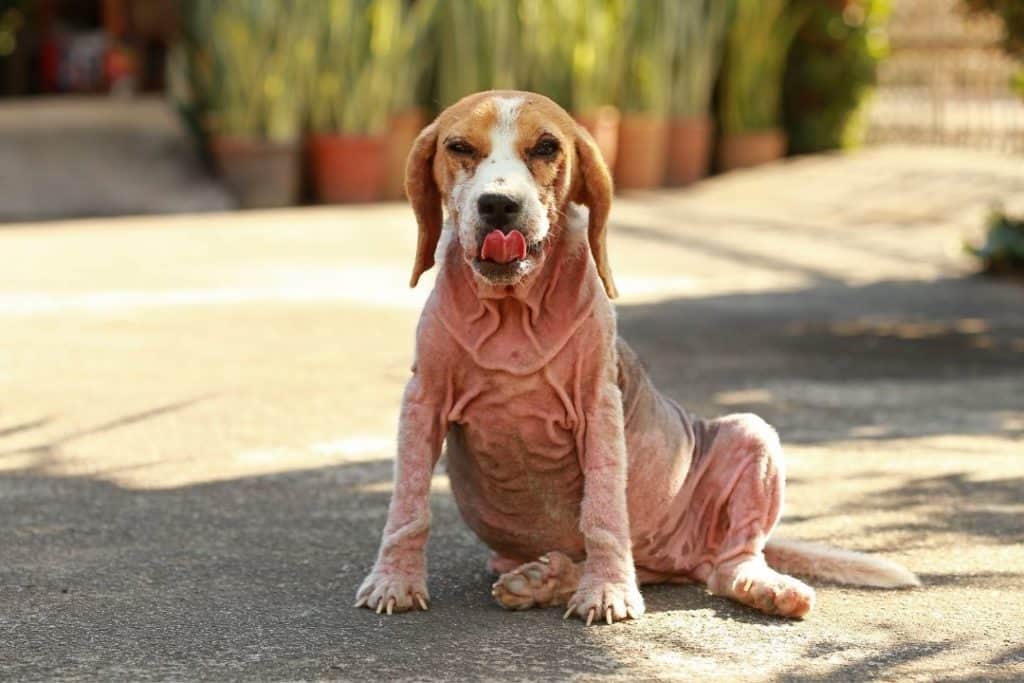
Many types of mites can take over your bully’s skin, but the most common type of parasite for American bullies is demodicosis mites.
Demodicosis mites, also known as Demodex or red mange mites, are commonly found on American bullies and other dogs with prominent skin folds. These mites often live on dogs with no issues, but if they begin to multiply and spread quickly, they could cause some discomfort to your furry friend.
Mites like the Demodex are more common in young dogs and puppies since they have not developed a robust immune system. However, they can infest adult dogs, too.
Demodicosis mites are microscopic, which makes them incredibly difficult to identify.
How To Diagnose Skin Mites Such as Demodicosis Mites
Symptoms of a mite infestation are:
- Hair loss and dandruff in the affected area
- Itching
- Irritation and redness
- Bacterial or fungal skin infections in the affected area
To positively identify the parasites, vets scrape the surface of the affected area to remove the outer layer of dead skin and analyze it under a microscope. If the mites are present, you have a diagnosis.
Getting your vet to diagnose the mites for you is essential since you likely won’t be able to see the tiny insects on your own.
How To Treat Skin Mites Such as Demodicosis Mites
When your dog has mites, prompt and effective treatment is crucial. Mites aren’t just uncomfortable, but they can be contagious and do permanent damage to your pup, so if you suspect that mites are the issue, it’s time to head over to the vet.
Usually, the best treatment for any mites is an anti-parasitic shampoo. These shampoos can kill mites, eradicating them over a month or two of use. So, it will take patience to get rid of mites, but it is possible, and your bully will surely be grateful.
6. Eczema
Eczema is a skin condition that is very common in American bullies. However, this skin issue is not a disease. Instead, it is a symptom of a more significant problem, and most of the leading causes of eczema are even incredibly common in American bullies.
Eczema can be onset by other conditions such as CAD, pyoderma, infections, and mites. These other issues can irritate the skin so much that it develops painful, itchy hot spots where the skin either oozes or dries out in an attempt to fight off another infection, eliminate an allergen, or eradicate pests.
Still, some other factors may cause eczema, such as a lack of essential vitamins, contact with toxic chemicals or plants, or extremely hot or dry weather.
How To Diagnose Eczema
There are two main types of eczema– wet and dry. Each class has different symptoms. So, eczema won’t look the same in every case.
Eczema, regardless of whether it is wet or dry, has the following symptoms:
- Redness and irritation in patches
- Hot spots
- Thick skin patches
- Constant itching, often to the point of injury
- Hair loss
As the name implies, wet eczema is characterized by moist, sticky, sometimes oozing patches of skin surrounded by damp, matted fur. Often, these patches are oily and raw-looking, and they tend to bleed more than dry eczema patches since they are too moist to scab over well.
However, dry eczema looks quite the opposite. The symptoms include dry, scaly skin with dandruff, thick, hard spots, and darkened callouses. Usually, the skin is so dry that it cracks, leaving crusty discharge and hard scabs.
This condition can be challenging to diagnose since it presents itself much like many other common skin conditions on this list. Also, eczema usually means that your bully has another skin condition, so it often takes a vet to make a positive diagnosis.
How To Treat Eczema
Since eczema is not chronic or communicable, you usually have to find an underlying issue before alleviating the symptoms. However, the primary goal of eczema treatment is to lessen the itching and pain of your pup.
Medicated shampoos with anti-itch agents such as cortisol, essential oils, or oatmeal can help soften and heal eczema patches. In addition, they may be able to remove allergens, mites, bacteria, and fungi from your dog’s coat, which could help you treat the underlying issue behind your dog’s eczema.
Topical anti-itch sprays can also provide some temporary relief to your bully, though they won’t fix the more significant issue or cure eczema.
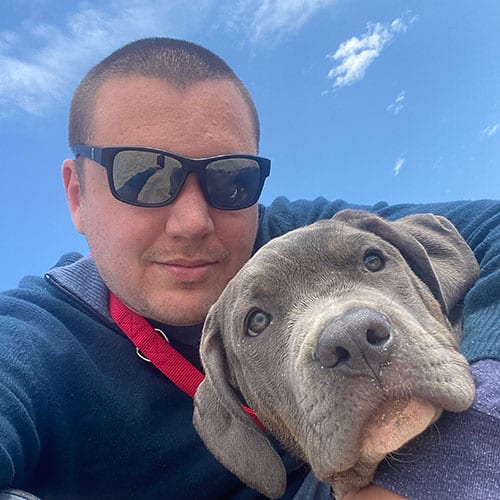
I created this blog to share my passion for bullies, and help current and future pitbull owners with things like diet and education.
Hope you find it useful, don’t hesitate to drop a comment on my articles!

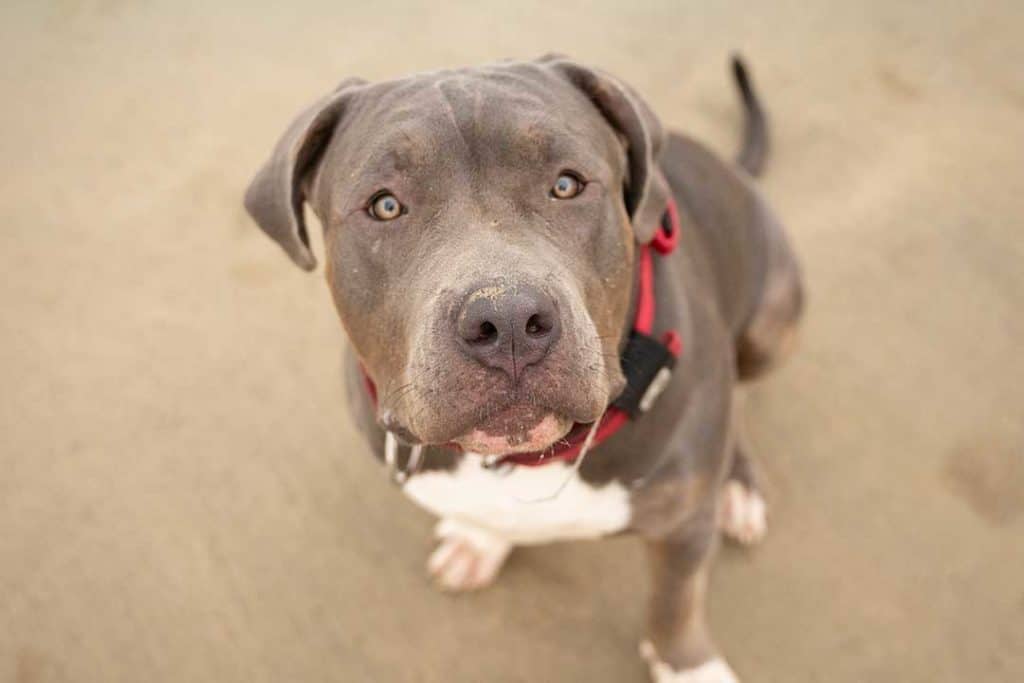

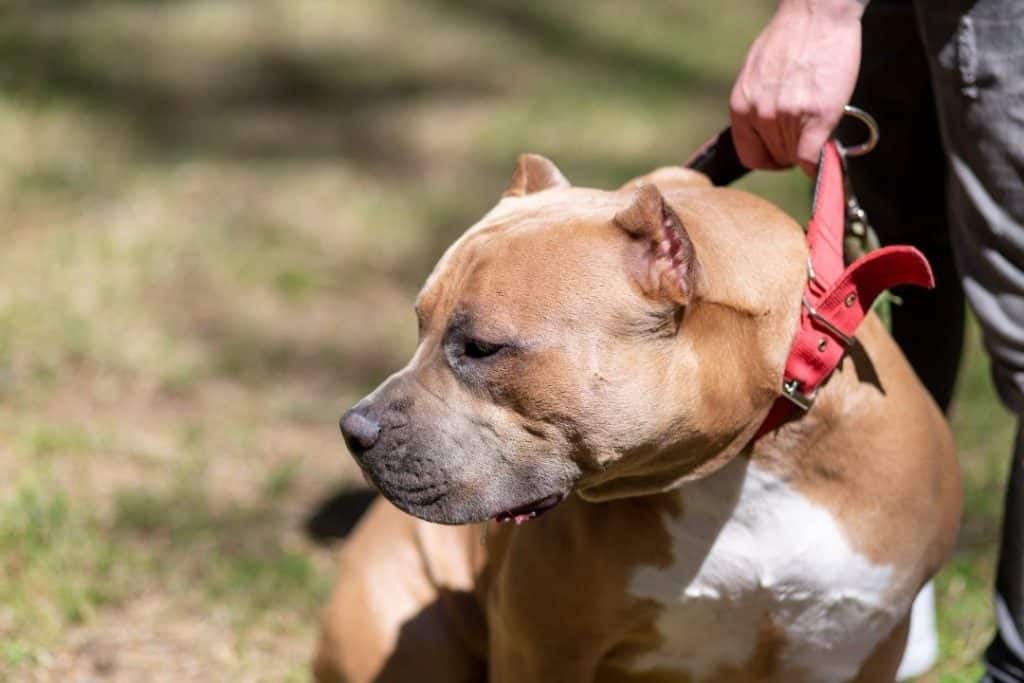
Hi your XL looks a lot like mine, though i believe shes a classic.
She definitely has CAD and id guess Ichthyosis as well.
Been to the vet multiple times. They told me to do a process of elimination with her diet. They actually said grain free is horrible, what are your thoughts on that?
Her belly is pretty much hairless from the scratching. Back legs as well. Legs probably have Ichthyosis bc her skin there looks scaly.
Any additional advice you can give me?
This was a fantastic article you provided btw